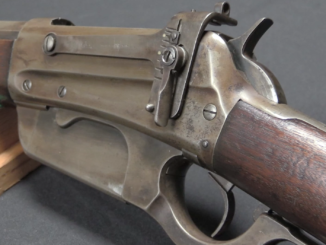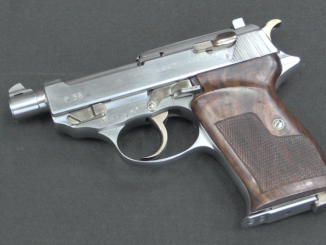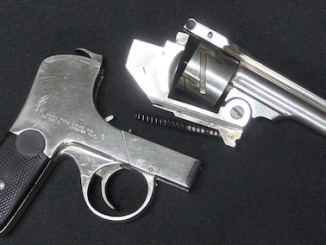The US military experimented with a wide variety of breechloading carbines during the Civil War. One of these that got a bit of a head start on the others was the Smith carbine, patented in 1855-57 by Gilbert Smith, a physician from New York. He contracted with Poultny & Trimble of Baltimore – a major arms and military accoutrements dealer – to market the gun, and he received his first military order in February of 1860. That first order was on for 300 guns, but it meant that the design was a known quantity to the military when war broke out. Throughout the war a series on contracts were written for a few thousand Smith carbines as a time, with final deliveries made in June 1865 and a total of just over 31,000 delivered to the military. Prices steadily dropped form $35 per gun before the war to just $23.50 by the final contract.
The Smith was a break action design using a cartridge made of India rubber. It was a capping breechloader, meaning that ignition was provided by a traditional primer on the side of the action, and not through a primer integral to the cartridge. This rubber system was a reliable obturator, and the Smith received generally positive reviews from cavalry units that used it in combat.
Sold for $2,070 at the December 2019 RIA Premier auction.




Love these Civil War guns and the extra info you present with them.
“Eras Gone” has a video showing photos of the original cartridge and modern repros for those who might own, and wish to shoot, this weapon.
https://www.youtube.com/watch?v=dM-83GJ8isM
Obdutator?
No, obturator. Something that closes or blocks an opening. In other words, it made a good gas seal.
“(…)India rubber(…)”
Wait. Does it count as polymer? If yes Smith predates polymer-cased cartridges of 20th century.
“(…)obturator(…)”
For comparison in canon de Bange de 90 (produced in France since 1877) asbestos was used in this role:
https://guns.fandom.com/wiki/De_Bange_90mm
The obturator was made of asbestos as it was effective at blocking heat and resistant to pressure.
“(…)Rubber Cartridges(…)”
This is reminder that while metal-cased (brass, sometimes steel) are obvious for us, choice was not so in 1850s. It needs to seal breech, could be stored for long time and remain usable in various environments, yet to be acceptable price-wise. Note aversion of some higher staff to rapid firing rifle (“our soldiers will waste ammunition!”) and yet imagine how would they react to information of this rifle allow firing X times faster and every shot is Y times more expensive.
It’s not quite accurate to say that the Union was well set up to supply rifle muskets to its rapidly-expanding army. It would be more correct to say that rifle muskets were the only modern arms likely to be available in anything like the numbers needed.
At the time, the United States had exactly two actual arsenals capable of manufacturing infantry rifles; Harper’s Ferry, Virginia (now WV) and Springfield Arsenal, Massachusetts. Harper’s Ferry rather quickly fell to the Confederates, was burned to deny its use to them, but much of the machinery was salvaged and sent to Richmond, where it would be used to produce small arms literally up to Appomattox.
Also, the Springfield manufactory was totally inadequate to supply arms in the numbers needed.
The result was that for the first year and a half of the Civil War, most infantry rifle muskets used by the Union were imported from Europe. And while most were well-made weapons, some were not.
The whole story can be found here;
https://ia801709.us.archive.org/11/items/Civil_War_Guns/Civil_War_Guns.pdf
Contrary to myth, the main problem was not General Ripley. It would be more accurate to say that it was that nobody anticipated just how big this war was going to be.
cheers
eon
Obturation. US bag loading artillery has used the De Bange system for over a century
https://en.wikipedia.org/wiki/Charles_Ragon_de_Bange#De_Bange_breech_obturator_system
Obturation in small arms and artillery using fixed ammunition (aka “Qick Fireers”) is that the case provides the obturation rather than the (usually sliding wedge) breech block or bolt
2. Eon, the Union was not limited to the two Arsenals. Since earlies times, government production had been augmented by commercial. The Union’s manufacturing capacity was so
vast that in the 1850’s, a delegation from RSAF Enfield Lock toured the Connecticut River Valley to learn about “The American System” of manufacturing. Ripley was guilty of many things, in this case, not properly organizing and managing that vast industrial base.
I had the pleasure of handling one of these at a North South Skirmish Association event back in the eighties. My host at that event was competing reasonably well with it. There were bright orange plastic modern cases for it. Of course he needed a .50 BMG ammo can full for the weekend. My own family had kept at least three firearms from their service, one was an Austrian large , smooth bore carbine with a tape primer device on it.
A handsome old iron, and that specimen is wonderfully preserved.
Watching it hinge open made me wince a little. Field usage would have subjected that bolt and the colliding faces of the barrel and breech to some pretty high stresses.
I wonder: did the rubber cartridge combust, or did the empty have to be plucked out of the breech?
https://www.guns.com/news/2013/07/02/the-civil-war-smith-carbine-the-case-for-rubber
“Moreover, these exotic cases would foul the chamber so bad when fired that after a few dozen shots the gun was unusable until cleaned.”
Article: “The Hated Smith Carbine”
https://pdfslide.net/documents/the-hated-smith-carbine.html
They made plastic cartridges for the Smith carbine as it was/is very popular for North/South Skirmish Assn (NSSA) shooting. Shootable specimens were not rare in the 1950s and 1960s. They were so popular that eventually, replica Smith carbines were made.
I just inherited a firearm that is identified as follows:
Serial Number 8998 Single 50 Cal. Bullet in a casing. Breechloading breaks open by a plunger type lever pushed upward in front of the trigger which is also located in the trigger area.
MFG. Mass. Arms Co. Chicopee Falls.
Address Poultney & Trimble
Baltimore USA
Smith’s Patent June 28 1857.
Please let me know what I have as well as any other pertinent info you think i might need to sell auction or keep?
My phone number is (940) 257-9629 CST